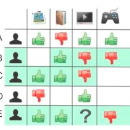The interactions of users and items in recommender system could be naturally modeled as a user-item bipartite graph. In recent years, we have witnessed an emerging research effort in exploring user-item graph for collaborative filtering methods. Nevertheless, the formation of user-item interactions typically arises from highly complex latent purchasing motivations, such as high cost performance or eye-catching appearance, which are indistinguishably represented by the edges. The existing approaches still remain the differences between various purchasing motivations unexplored, rendering the inability to capture fine-grained user preference. Therefore, in this paper we propose a novel Multi-Component graph convolutional Collaborative Filtering (MCCF) approach to distinguish the latent purchasing motivations underneath the observed explicit user-item interactions. Specifically, there are two elaborately designed modules, decomposer and combiner, inside MCCF. The former first decomposes the edges in user-item graph to identify the latent components that may cause the purchasing relationship; the latter then recombines these latent components automatically to obtain unified embeddings for prediction. Furthermore, the sparse regularizer and weighted random sample strategy are utilized to alleviate the overfitting problem and accelerate the optimization. Empirical results on three real datasets and a synthetic dataset not only show the significant performance gains of MCCF, but also well demonstrate the necessity of considering multiple components.
翻译:用户和推荐人系统中项目的互动自然可以作为用户-项目双片图进行模拟。近年来,我们目睹了为协作过滤方法探索用户-项目图的新兴研究努力。然而,用户-项目互动的形成通常来自高度复杂的潜在购买动机,如成本高性能或目光捕捉外观,这些都无法分辨地代表边缘。现有方法仍然存在着各种购买动机之间尚未探索的差别,从而无法捕捉细微的用户偏好。因此,我们在本文件中提议了一种新型的多成份图形共振合作过滤(MCCC)方法,以区分观察到的明显用户-项目互动中的潜在购买动机。具体地说,在MSCC内有两个精心设计的模块,即分解器和集眼神的外观。前一种方法在用户-项目图中将边缘分解,以确定可能导致采购关系的潜在组成部分;后一种方法则自动重新研究这些潜在组成部分,以便获得统一的嵌入。此外,对于观察到的明显用户-项目互动关系中的潜在购买动机(MCF)过滤(MCCF)方法,稀少的固定和加权随机抽样战略中的一些潜在动机动机,也用于减轻重要的数据问题。




